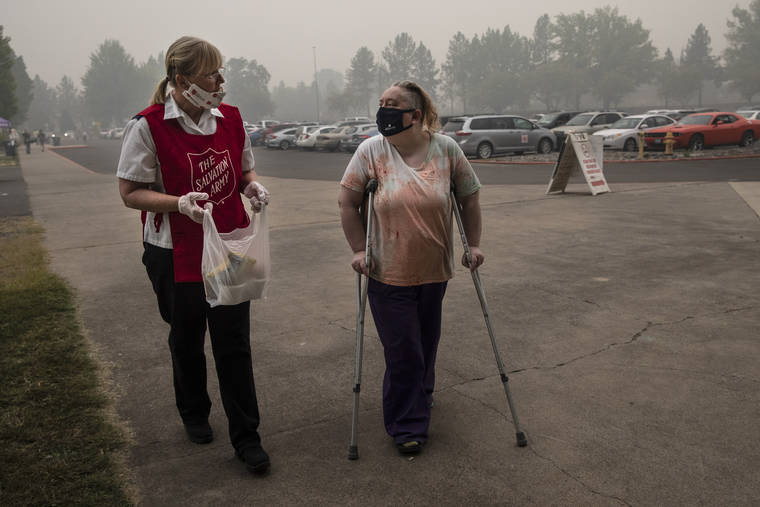SALEM, Ore. — Tens of thousands of people have been forced to flee their homes as destructive wildfires roar across the West Coast, and many of them could end up in shelters, raising potential health risks during the coronavirus pandemic.
The shelters’ impact on public health is “an unusually important and under-researched topic,” said Karl Kim, executive director of the National Disaster Preparedness Training Center, which trains first responders. “People are really scrambling right now to figure out how this affects the guidance and messaging and so forth.”
Large disaster response organizations like the American Red Cross are requiring masks and trying to keep evacuees at least 6 feet (2 meters) apart, but it can be difficult for people already reeling from a disaster to consistently follow the rules.
Kathy Gee, 68, has diabetes and other conditions that make her vulnerable to the virus, but that didn’t kept her from evacuating from her farm in Molalla, Oregon, to a shelter in Portland.
“If it’s going to happen, it’s going to happen. I’m tough,” she said. “I’ve survived lots of things. I can survive that.”
At the Oregon State Fairgrounds in the capital of Salem, groups of maskless evacuees gathered in a parking lot and a barn Friday, talking about the unprecedented wildfires that have destroyed an area greater than the size of Rhode Island. Volunteers wearing disposable masks walked from group to group, taking down their information and asking what they need for the days ahead.
Signs plastered the doors of the exposition center, where cots were set up, with safety guidelines for both wildfires and the pandemic. Inside, nearly everyone wore masks, likely because volunteers manning the door reminded them to do so.
The fires in California, Oregon and Washington state have killed several people and left dozens missing. In the three states, 6,300 are already in emergency Red Cross shelters and hotels and as many as 50,000 more could be before the blazes are under control, said Brad Kieserman, vice president of disaster operations and logistics for the American Red Cross.
Normally, they’d be gathering in school gymnasiums and meeting halls, sleeping on cots and eating at buffet lines, all provided by organizations like the Red Cross, Salvation Army and other faith and community groups. But because COVID-19 is airborne and easily spread in close quarters, gathering places are potential hotbeds of transmission. That’s got disaster assistance groups taking a different approach.
“Noncongregate shelters is a new pandemic thing,” Kieserman said. “The last thing we want to have happen is people to remain in the path of a wildfire or hurricane because they think it’s safer to do that than risk a shelter.”
The Red Cross is trying to prevent the virus from spreading at shelters by regularly testing staffers, cleaning and disinfecting often, requiring masks and screening evacuees for signs of illness. Those who are sick or have symptoms are sent to special isolation shelters and kept away from one another. When possible, displaced residents are sent to hotels instead of group shelters. Instead of buffet lines, box lunches are delivered.
“We’re not using a gym, we’re renting a hotel room at 120 dollars a night. And hotels charge for parking — it’s all those things you never think about during a disaster,” Kieserman said.
In central California, where thousands of residents had to flee the Creek Fire, more than 1,200 evacuees are staying at 30 hotels, said Tony Briggs with the Red Cross in Fresno. In group shelters, staffers are using plastic pipes strung with clear shower curtains to separate evacuees but allow them to see out from their own socially distanced areas.
Mass evacuations of this scale are incredibly difficult, said Kim, who’s also director of the Disaster Management and Humanitarian Assistance Program at the University of Hawaii.
Generally, he said evacuees either leave early and quickly or aren’t as mobile and require some help getting out.
“The group I’m most concerned about are people with mobility challenges,” he said. “They may have health or other challenges that make it difficult to get information and act quickly, or elderly people who live alone, or people with animals may also have lots of disincentives to want to evacuate.”
They might decide to wait it out longer and also are more likely to need shelters, he said. Some of them could be at greater risk of COVID-19 complications.
In Oregon, group shelters are set up at churches, colleges and community buildings, while malls, golf courses and other businesses opened parking for evacuees who can stay in recreational vehicles.
It will likely be weeks before officials know if the evacuations contributed to the virus spreading, and even then, it may be difficult to tell as families scatter to new locations.
“Contract tracing is really critical during a pandemic, and just because there’s a wildfire, all of the needs associated with contract tracing don’t just go away,” Kim said. “I think it’s more complicated because of the urgent nature of the evacuation. We don’t have good systems for this; nonetheless, we need to do that tracking. That’s the ongoing public health challenge.”
Some lessons may be learned from Louisiana and Texas. Both had high rates of COVID-19 when hurricanes hit in late August.
Louisiana used its “Megashelter,” a facility spanning more than 200,000 square feet (18,580 square meters) that’s designed to hold nearly 4,000 evacuees, for those with special medical needs during Hurricane Laura. Others got help finding hotel rooms and vouchers to cover the cost. Louisiana health officials are now offering evacuees mobile COVID-19 testing.
———
Boone reported from Boise, Idaho, and Associated Press writers Lindsay Whitehurst in Portland and Suman Naishadham in Phoenix contributed.


